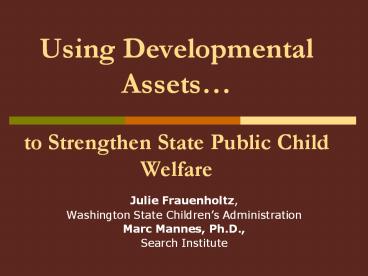Using Developmental Assets - PowerPoint PPT Presentation
1 / 21
Title:
Using Developmental Assets
Description:
Well-Being = developmental success. Employing a Developmental ... Communities, Families, and Youth with safety, stability, permanency, and well being for all. ... – PowerPoint PPT presentation
Number of Views:177
Avg rating:3.0/5.0
Title: Using Developmental Assets
1
Using Developmental Assets to Strengthen State
Public Child Welfare
- Julie Frauenholtz,
- Washington State Childrens Administration
- Marc Mannes, Ph.D.,
- Search Institute
2
Stetting the Stage
- The Dance of.
- Search Institute and Washington State
- Asset Development and Snohomish County
3
The Developmental Assets Approach
Reduction of Risk Behaviors
DevelopmentalAssets
The more,the better
The more,the better
Promotion ofThriving
4
Encouraging Child and Youth Serving Agencies
to
- Become more
- DEVELOPMENTALLY ATTENTIVE
- Emphasize a
- DEVELOPMENTAL APPROACH
5
Federal Performance Goals
- Safety
- Permanency
- Well-Being
6
Goals with an Emphasis on Development
- Safety emotional and psychological security
- Permanency building healthy relationships
- Well-Being developmental success
7
Employing a Developmental Approach
- Is a way for public child welfare to emphasize
Development by - Fostering Resilience
- Concentrating on Protective Processes
- Being Promotional
- Focusing on Positive Behaviors
8
Understanding Resilience
- Resilience A Universal Capacity
- A consistent yet amazing finding over the last
two decades of resilience research is that most
children and youth, even those from highly
stressed families or resource-deprived
communities, do somehow manage to make decent
lives for themselves. In fact, for just about
any population of children that research has
found to be at greater risk than normal for later
problems children who experience divorce, live
with step-parents, lose a sibling, have attention
deficit disorder, suffer developmental delays,
become delinquent, run away, get involved with
religious cults, and so on more of these
children make it than do not (Rhodes Brown,
1991).
9
The Power of Resilience
- What began as a quest to understand the
- extraordinary has revealed the power of the
ordinary. Resilience does not come from rare and
special qualities, but from the everyday magic of
ordinary, normative human resources in the minds,
brains, and bodies of children, in their families
and relationships, and in their communities
(Masten, 1999).
10
The Importance of the Protective
- Researchers who have studied resilience
- point out that protective processes, or
- buffers, appear to have a more significant
- impact on the lives of children and youth
- who experience adverse conditions than
- particular risk factors or traumatic situations.
11
The Universality of Protective Processes
- Buffers protective factors make a more
profound impact on the life course of children
who grow up under adverse conditions than do
specific risk factors or stressful life events.
They appear to transcend ethnic, social class,
geographical, and historical boundaries - (Werner Smith)
12
Impact Associated with the Protective
- Family-focused programs are generally
- More effective for families with
- Relationship problems than either child
- or parent focused, particularly if they
- emphasize family strengths, resilience,
- and protective processes rather than
- deficits.
- (Kumper Alvarado, 2003)
13
Re-Imagining the Work with an Emphasis on
Development
14
Positive Behavior Focused
- Protective Factors/ Processes
- Supports and
- Opportunities for
- Healthy Development
- and Developmental
- Well-Being
Risk Reduction
Promotion
Problem Behavior Focused
- Risk Factors/Processes
- Threats to Development
- Developmental Deficits
15
How we are doing our work?
Family to Family A family centered, neighborhood
based system of public child welfare.
Evidence Based Programs
Goal Strong and Healthy Communities, Families,
and Youth with safety, stability, permanency, and
well being for all.
Solution-Based Case Work A new practice model for
Children's Administration to better engage with
families.
Developmental Assets A simple framework for
defining qualities and experience youth need.
16
Reasons to infuse the asset framework ...
- Development of Resources
Practice Integration for Family Well- Being
Involvement with Community
17
Tools
- Opportunities for Asset Training/ Orientation
- Search Institute Materials and Resources
- Developmental Asset Profile with Implementation
Guide - Compliments strength based approach to social
work. - Dr. Marc Mannes, Statewide vision.
18
Emphasis on Social Learning
- Relationship Building
- Shared Learning- Circle Back
- Creating a Network
- Lynns Unit
19
Community Partnerships
- Training of Trainers
- Community Mobilizing in Snohomish County- Sharing
Strategies - Quarterly Meetings
- Shared Tracking and Evaluation
- Shared Goals
- Healthy Youth Survey Data
- Seeking out Foster Parents, Court Appointed
Special Advocates (CASA)/Volunteer Guardian Ad
Litems (VGAL), Judges, Schools, PTA, Churches,
Family to Family Strategy Groups, neighborhoods
to provide training.
20
Questions?
21
Thank you!































